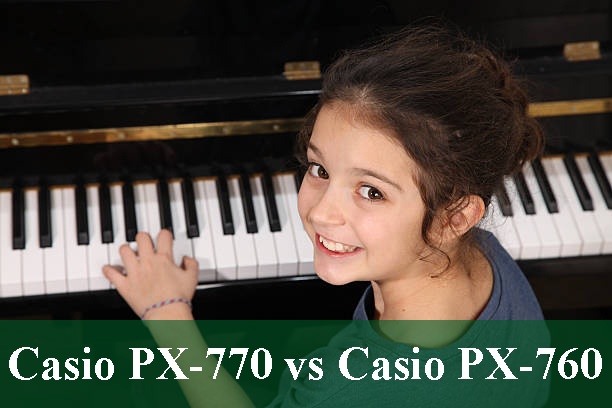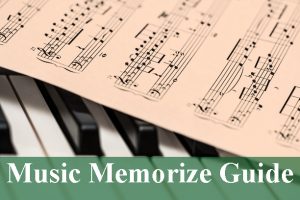Casio PX-770 vs Casio PX-760
Casio PX-770 vs Casio PX-760: In comparison to the more seasoned Casio PX-760, the contrast among it and the PX-770 are very little. Nonetheless, the updates that Casio has made to the PX-770 are unquestionably essential, making the more up to date demonstrate the one you should focus of the two (except if there’s an open door for you to get the PX-760 at altogether bring down cost).
Initial, an enhanced sound chip onboard the PX-770 gives a more regular sound resonance, and longer right-pedal continue times.
Next, each of the 19 instrument voices have been updated, and there is presently one additional acoustic piano solid.
The redesigned bureau construction, with less creases and sleeker inherent speakers, give the PX-770 an extremely engaging look, too. Unquestionably this is a digital piano that you’re purchasing for the touch, feel, and sound above all else. In any case, it’s consoling to realize that you can put this piano in your family room or room and realize that it won’t be a blemish.
The bureau is additionally significantly more lightweight than the most recent of the Casio Privia arrangement, the PX-870, which has a strong, heavier, encased bureau.
One of the best features of the Casio PX-770 is its sticker price. The quantity of features, voices and backups offered by the PX-770 for the expense is unsurpassable. Be that as it may, the PX-770 does not accompany a piano seat, so you should buy one freely to genuinely reproduce the acoustic piano experience.
The PX-760
The PX-760 in three distinct completions (Satin Black, Lucid White and Oak Brown) with the accompanying:
- Casio PX-760 88-key digital piano
- Furniture-style remain with incorporated music rest and three-pedal framework
- Score Book
- Air conditioning connector
- Proprietor’s manual
In spite of being an upstanding like digital piano, the PX-760 offers a minimized stand that can be effectively set inside any room. Obviously, similar to every one of the pianos of this sort, the Casio PX-760 isn’t designed to be conveyed: while being one of the most lightweight models of its sort available, the PX-760 still loads about 70 pounds when completely collected.
This refreshed version incorporates a more dominant speaker framework than the PX-750 (presently including two bigger 8W-speakers), which is all that could possibly be needed for playing in-house.
The general look is very like the past iteration, and there aren’t numerous progressions to the principle interface. What you arrive is very standard: a Power switch, a Volume handle, the Function button, the digital recorder controls (Start/Stop and Recorder), the Metronome/Beat mode lastly three buttons for a speedy access to the most utilized sounds.
On the back board there is a RJ terminal for connecting the triple-pedal framework (delicate, sostenuto and damper, which underpins the half-pedal functionality also), the USB port for MIDI capacities, a stereo yield and the power plug. The PX-760 incorporates two headphones ports, which are extraordinary for the two instructors and understudies who wish to rehearse peacefully.
Features of The PX-760
The PX-760 incorporates all the most vital features of the past model, for example, Casio’s eminent Multi-dimensional Morphing AiR sound motor and the 88-key Tri-Sensor Scaled Hammer-Action Keyboard II, which is presumably the most refreshing weighted keybed that is evaluated under the $1000.
The PX-760 has improved with another arrangement of sounds as well, particularly the amazing piano, the strings and the electric pianos. There are a sum of 18 distinct sounds that are accessible in the PX-760, including five thousand pianos. There are additionally organs, basses and different voices to boot.
The 760 additionally offers a most extreme measure of polyphony set to 128 concurrent notes, which is extraordinary at this cost range and enables understudies to approach arpeggios and middle of the road bits of traditional music without stressing over any dropped notes.
The authenticity and expressivity of the piano experience is improved by a few emulations here too with the Damper Resonance, the Hammer Response and the Half-Pedal help. Every one of the three of these reproduce the diverse mechanical subtleties of an acoustic piano, which is the thing that any piano player pines for.
The spring-less mallet action keyboard with ebony and ivory finished keys guarantees a characteristic and sensible inclination under at the tip of your finger. Additionally, the three accessible sensors on the PX-760 can catch even the most sensitive changes of speed with mind boggling precision and speed.
The keyboard is obviously reviewed distinctively on every octave, with the goal that the lower keys are heavier and the higher keys are lighter, much the same as any genuine piano. You can clearly change the key responsiveness picking between four unique qualities, also.
At the point when consolidated together, the redid sound motor and the sledge action keyboard give one of the best piano playing encounters one could have in this value extend. The new piano stable on the 760 is superior to the 750, and this feature alone would be a strong reason to consider buying this updated model over its antecedent.
The Casio PX-770
The Casio PX-770 incorporates 19 redesigned instrument sounds, including:
- 5 Grand Pianos
- 4 Electric Pianos
- 4 Organs (Jazz, Pipe, 2 Electric)
- 2 Strings
- Harpsichord
- Vibraphone
- Bass
The PX-770’s five thousand piano voices truly catch and include the lavishness and marginally unique sounds and tones of various acoustic fabulous pianos. From my personal experience playing a huge number of various makes of great and child fabulous pianos, the Casio PX-770 works superbly reproducing the distinctive tone quality, resonance and note rot of five diverse terrific pianos.
With its 19 instrument sounds, 18 worked in tones with split and layer functions, 128-note polyphony and 8 on-board reverb/ensemble impacts, the PX-770 is superior to anything its competition (all around, in light of cost, at any rate), flaunting the most practical sounding compilation of instrument voices to include decent variety, expression and feeling to your music.
The PX-770’s Grand Piano voice has additionally been redesigned, and uses four unique dimensions of stereo-recorded examples of a genuine brand piano to convey the most practical, most powerful solid accessible on a unit in this value run.
Features of The PX-770
The PX-770 offers 88 full-measure, scaled sledge action keys which are splendidly weighted for genuine great piano playing action. The weight and depression of the keys is flawless to those of a genuine piano. Given its smaller size, the Casio PX-770 consummately matches a smooth design with a full-sized 88-key keyboard, giving the player an extremely common, extraordinarily sensible piano playing knowledge.
Taking a seat at the Casio PX-770 digital piano felt as near taking a seat at an acoustic piano as I have ever experienced. With regards to genuine feel play, the PX-770 couldn’t get a lot nearer to the real thing. From the 88-key range and touch-delicate, scaled mallet action keys to the Acoustic and Intelligent Resonator (AiR) processor, Casio absolutely won’t frustrate any fans that favorsd the past model the PX-760.
Much like that of its forerunner, the aforementioned Casio PX-760, the more up to date PX-770 features Tri-Sensor II Scaled Hammer Action piano keys for practical key-action. The gauged keys discourage and respond simply like those of a concert-style piano. Each key is touch-touchy, so players can expand the heaviness of their touch for a more intense, bolder fortissimo stable, or diminishing the heaviness of their touch for a gentler, milder pianissimo stable.
The weight and touch affectability of the scaled mallet action keys is uncanny. I’m not the slightest bit going to recommend that the PX-770 is likened to playing on an exceedingly costly acoustic piano, yet I will state that, given the critical contrast in expense between the PX-770 and an acoustic piano, it’s very astonishing how shut the keys can feel to the genuine article.
Regardless of the Casio PX-770 being a fantastic imitator of a genuine acoustic piano, it at last is a digital keyboard, and remains consistent with those features, also, including its shifting degrees of touch affectability.
Touch affectability can without much of a stretch be changed in accordance with one of three preset dimensions. The principal setting is minimal delicate to touch, and there is next to no distinction when the player plays with a substantial hand or a light touch. The second dimension of touch affectability has a slighter more extensive affectability to the players’ touch. Though the main dimension makes almost no solid change dependent on the heaviness of the players’ fingers, the second dimension is somewhat more delicate to finger weight.
In comparison, the third dimension of touch-affectability gives players the most generally powerful scope of touch-affectability. The lightest touch will convey a fragile pianissimo stable, while the heaviest touch will convey the boldest fortissimo.
It ought to be noticed that touch-affectability can likewise be killed, whenever wanted. At the point when touch-affectability is latent, the digital piano will play a similar volume tone for each time the keys are discouraged, paying little heed to the players’ touch.
All things considered, Casio’s endeavor to repeat the vibe of an acoustic piano continues, as the PX-770 features texturized keys.
Since assembling the more established PX-760 model, Casio has reformulated their engineered ivory and ebony materials used to give the piano a more characteristic, sensible, texturized keytop surface. Like the PX-760, the more up to date show PX-770 has somewhat finished keytops, yet the new materials and enhanced texturizing takes into account PX-770 players to have a considerably more sensible, normal experience.
In spite of the fact that texturized keys do give the Casio PX-770 leverage over different makes and models as far as the genuine feel play understanding, I didn’t observe their texturizing to be right on target to that of an acoustic piano.
Ivory is regularly smooth, and these keys are definitely not. In any case, there is a positive favorable position to the texturized keys they make it simpler for the player’s hands to remain solidly planted over the keys. With finished keys, you don’t need to stress that your fingers will slip off while playing.
With more resonance reproduction and normal note rot, the PX-770’s tone is altogether preferred and more practical over that of its more established sibling, the PX-760, also. Resonance reproduction is the digital reproduction of an acoustic piano’s strings and the manner in which that the sound waves from the strings of a piano are intensified dependent on every string’s resonance quality, or normal frequencies of vibration. Note rot is the regular length of a note played on an acoustic instrument until the point when it becomes dull to quietness.
Conclusion
The Casio PX-770 is a decent evolution of the PX-760. With another sound set, and features like Concert Play to oblige a redid speaker framework, obviously Casio has genuinely make a critical endeavor to enhance its much-refreshing PX-760.







